Big, Bold, and Handsome
Maine’s lobsterboats are getting bigger and bigger
 Top Left-Right: Misty Dawn, a Calvin Beal 44.Haulin’ Ash, a “Super 46” Wesmac. Hakuna Matata, a Libby 41. Havoc, a 46' Duffy. Resolute, a wooden 46-footer built by John’s Bay Boat Co. Logan Faye, an Osmond 42 stretched to 47'.
Top Left-Right: Misty Dawn, a Calvin Beal 44.Haulin’ Ash, a “Super 46” Wesmac. Hakuna Matata, a Libby 41. Havoc, a 46' Duffy. Resolute, a wooden 46-footer built by John’s Bay Boat Co. Logan Faye, an Osmond 42 stretched to 47'.Story & Photographs by Brian Robbins Most Maine boatbuilders who cater to commercial fishermen will tell you the same thing: 2014 was the year of the big boat. The majority of those big boats were built for lobstering—no surprise if you’re aware of the growth in lobster landings over the last several years along the coast. “I can’t believe some of the numbers I’m hearing,” said Steve Wessel of Wesmac Custom Boats in Surry. “Back when I was lobstering, you’d go offshore for a week and do well to get the poundage that some of these boats are getting in a single day now.” Those kind of numbers translate into a demand for bigger boats for the inshore fleet. In Wesmac’s case, the builder has responded by adding the new “Super 46” to its stable—46' in length by 17'1" wide at the beam. “Our 42- and 46-footers have been popular right along,” said Wessel, “but we’d get customer after customer who was looking for something wider.” Lash Brothers Boat Yard in Friendship launched the first “Super 46” earlier this year. Since then, Wesmac has taken orders for a string of them, to be finished both in-house and by other shops. Stewart Workman of SW Boatworks in Lamoine concurred with Wessel’s assessment: “The big boats have exploded. We have a slug of Calvin Beal 44s to build—hulls and tops to send out along with complete boats that we’re finishing ourselves.” With a collection of molds that includes the Calvin Beal-designed model line and the well-known Young Brothers hulls (designed by Ernest Libby, Jr.), Workman said that the 44'x17'6" Calvin was SW’s biggest seller for 2014.“If I’d had 20 Calvin Beal 44s in my yard ready to go, I could’ve sold every one of them this year,” he said. “It was nuts.” In November, SW had a modified Young Brothers 42' hull ready to ship. The boat had been split parallel to the keel on either side and widened from 15'8" to 16'6" to accommodate a customer’s request. Pointing to the smooth lines of the reconfigured bottom, Workman said he was pleased with the way the project came out, noting that it was still a one-off hull. “I’d like to have a mold for every new model, but you just can’t do it,” he said. “It’s too expensive.” H&H Marine no doubt agrees with Workman. However, their philosophy seems to be “Make the most out of the molds you have.” The Steuben shop offers many of its Osmond Beal hulls with beams that increase the original design widths by two feet or better. Plus, H&H’s Bruce Grindal reported enough interest in a longer version of the widened Osmond 42 (42'x17'6") to warrant molding an extension to take the design up to 46' LOA.
 Caleb & Brayden’s open stern shows off the Wayne Beal 46’s large working deck.
Caleb & Brayden’s open stern shows off the Wayne Beal 46’s large working deck.
















